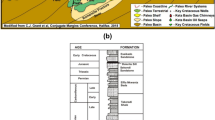Abstract
From six different production wells in the Camurlu Field, which is one of the important production regions in South Eastern Turkey, gas samples were investigated for their molecular and isotopic composition in order to determine origin of gases and probable source rocks. TOC measurements, kerogen isotope analysis and Rock-Eval pyrolysis analyses were also performed using cutting samples taken from three different wells in order to determine the characteristics of probable source rocks and to utilize this data for isotopic modeling. It was specified that kerogen isotope values of these samples varied between \({\delta^{13}}\) C −28.0 and −22.9 ‰. Stable carbon isotope ratios of Camurlu gases were determined as \({\delta^{13}}\) C1: −38.2 to −33.6 ‰, \({\delta^{13}}\) C2: −32.9 to −29.1 ‰, \({\delta^{13}}\) C3: −31.1 to −29.1 ‰, respectively. In the classifications conducted according to methane, ethane and propane \({\delta^{13}}\) C and methane \({\delta{\rm D}}\) isotope values, it was observed that Camurlu gases are thermogenic gases. Isotope modeling was applied in order to determine the characteristics of the probable source rock that generated the thermogenic Camurlu gases. In the isotope modeling according to methane–ethane, ethane–propane isotopes, it was determined that hydrocarbon gases were generated from a single source rock and its maturity varies between 0.8 and 1.0 (%Ro). Organic matter type of the source rock was specified as a mixture of Type II and Type III kerogen. As a result of the assessments made, it was found that the source rock of Camurlu gases can be the Paleozoic source rocks.
Similar content being viewed by others
References
Gürgey, K.: Genetic classification of the SE Turkey oils and delineation of source rocks types with the use of biological markers. METU, Ph.D. Thesis, 320 p. (1991)
Sari A., Bahtiyar I.: Geochemical evolution of the Besikli oil field, Kahta, Adiyaman, Turkey. Mar. Pet. Geol. 16, 151–164 (1999)
Erik N.Y., Özçelik O., Altunsoy M., İlleez İ.: Source-rock hydrocarbon potential of the Middle Triassic–Lower Jurassic Cudi Group Units, Eastern Southeast Turkey. Int. Geol. Rew. 47, 398–419 (2005)
Soylu C., Yalçın M.N., Horsfield B., Schenk H.J., Mann U.: Hydrocarbon generation habitat of two Cretaceous carbonate source rocks in SE Turkey. J. Pet. Geol. 28, 67–82 (2005)
Çelikdemir, E.; Dülger, S.; Görür, N.; Wagner, C.; Uygur, K.: Stratigraphy, sedimentology, and hydrocarbon potential of the Mardin Group, SE Turkey, In: Spencer, A. M. (eds). Generation, Accumulation, and Production of Europe’s Hydrocarbon: European Association of Petroleum Geoscientists, Special Publication 1, pp. 439–454 (1991)
Connan J., Kavak O., Akın E., Yalçın M.N., Imbus K., Zumburge J.: Identification and origin of bitumen in Neolithic artefacts from Demirköy Höyük (8100 BC): Comparison with oil seeps and crude oils from Southeastern Turkey. Org. Geochem. 37, 1752–1767 (2006)
Yılmaz, E.; Duran, O.: Güneydoğu Anadolu bölgesi otokton ve allokton birimler stratigrafi adlama sözlüğü. TPAO 31, 460 p. (1997)
Vaezian, A.; Ziaii, M.; Kamali, M.R.; Khaleghi, M.: An evaluation on geochemical characteristics of some probable source rocks of Salman oil field in the Persian Gulf. Arab. J. Sci. Eng. 39, 5653–5663
Kazemian, S.; Huat, B.K.; Mohammed, T.A.; Farah, N.; Aziz, A.A.; Moayedi, H.; Barghchi, M.: Influence of peat characteristics on cementation and pozzolanic reactions in the dry mixing method. Arab. J. Sci. Eng. 36, 1189–1202
Tissot B.P., Welte D.H.: Petroleum Formation and Occurrence. Springer, Berlin (1984)
Bernard B.B., Brooks J.M., Sackett W.M.: Light hydrocarbons in recent Texas continental shelf and slope sediments. J. Geophys. Res. 83, 4053–4061 (1978)
Schoell M.: The hydrogen and carbon isotopic composition of methane from natural gases of various origins. Geochem. Cosmochem. Acta 44, 649–661 (1980)
Whiticar M.J., Faber E., Schoell M.: Biogenic methane formation in marine and freshwater environments: CO2 reduction vs. acetate fermentation—isotope evidence. Geochim. Cosmochim. Acta 50, 693–709 (1986)
Whiticar, M.J.: Correlation of natural gases with their sources. In: Magoon, L.B., Dow, W.G. (eds.) The Petroleum System—From Source to Trap, AAPG Memoir 60, 261–283 (1994)
Prinzhofer A., Huc A.: Genetic and post-genetic molecular and isotopic fractionations in natural gases. Chem. Geol. 126, 281–290 (1995)
Hunt J.M.: Petroleum Geochemistry and Geology. 2nd edn. Freeman, San Francisco (1996)
Dai J., Yang S., Chen H., Shen X.: Geochemistry and occurrence of inorganic gas accumulations in Chinese sedimentary basins. Org. Geochem. 36, 1664–1688 (2005)
Chung H.M., Gormly J.R., Squires R.M.: Origin of gases hydrocarbons in subsurface environments: theoretical considerations of carbon isotope distribution. Chem. Geol. 71, 97–103 (1988)
Berner U., Faber E.: Empirical carbon isotope/maturity relationships for gases from algal kerogens and terrigenous organic matter, based on dry, open-system pyrolysis. Org. Geochem. 24, 947–955 (1996)
Author information
Authors and Affiliations
Corresponding author
Rights and permissions
About this article
Cite this article
Hoşgörmez, H., Soylu, C. & Bahtiyar, İ. Prediction of Source Rock Characteristics of Hydrocarbon Gases in the Camurlu Field (South Eastern Turkey) by Isotopic Modeling. Arab J Sci Eng 40, 1887–1895 (2015). https://doi.org/10.1007/s13369-014-1507-7
Received:
Accepted:
Published:
Issue Date:
DOI: https://doi.org/10.1007/s13369-014-1507-7




